The Economics and Statistics Division maintains archives of previous publications for accountability purposes, but makes no updates to keep these documents current with the latest data revisions from Statistics Canada. As a result, information in older documents may not be accurate. Please exercise caution when referring to older documents. For the latest information and historical data, please contact the individual listed to the right.
<--- Return to Archive
For additional information relating to this article, please contact:
March 23, 2022CANADIAN INCOME SURVEY, 2020 Statistics Canada has released results from the Canadian Income Survey, reporting on incomes for 2020. This includes average and median incomes as well as Canada's official poverty rate, as assessed against the Market Basket Measure.
Note that there were significant government income supports during the COVID-19 pandemic which drove a large decline in the poverty rate in 2020.
Poverty Rates
The Market Basket Measure (MBM) estimates the share of the population that do not have sufficient income for a reference family to afford the cost of a basket of essential goods and services. The MBM threshold is estimated for specific communities. In Nova Scotia, there are separate thresholds for MBM in Halifax, Cape Breton, communities with populations between 30,000 and 100,000, communities with populations under 30,000 and rural areas. The Market Basket has recently been updated to 2018, with historical estimates provided back to 2015. These data are collected through the Canadian Income Survey. Indicators of poverty and income for smaller sub-components of the population may be of limited data quality.
The poverty rate was 7.7% in Nova Scotia in 2020. Nationally, 6.4% of the population had income below the MBM threshold. The lowest poverty rate was in Quebec and the highest in Nova Scotia, followed closely by Prince Edward Island, New Brunswick and British Columbia.
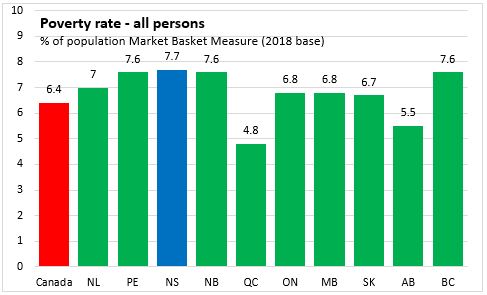
Poverty rates have been declining across Canada. From 2019 to 2020 all provinces saw a significant decline in the overall poverty rate. Nova Scotia's poverty rate fell from 12.0% to 2019 7.7% in 2020. The national poverty rate declined from 10.3% to 6.4%. The largest improvements in poverty rates were observed in Saskatchewan, Prince Edward Island and Manitoba.

The largest group of persons in poverty in Canada is found among those who are not in economic families followed by couples with children. Although poverty rates among lone parent families are higher across the country, this is a relatively smaller portion of the population and does not contribute as much to the poverty rate.
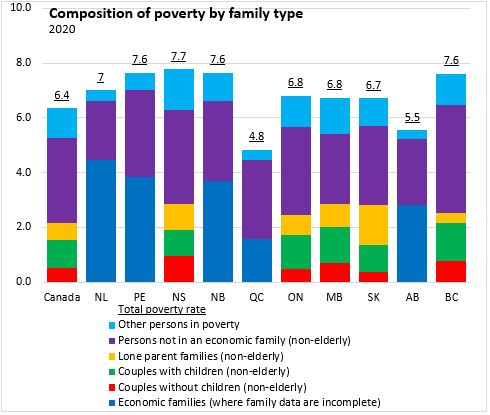
Compared with the national average, Nova Scotia's population has a higher share of elderly families, elderly persons not in an economic family, non-elderly couples without children, lone parents, and non-elderly persons not in an economic family.
Nova Scotia's population has relatively fewer non-elderly couple families with children, non-elderly other families as well as non-elderly couples living with other relatives.

Couple families without children generally have lower poverty rates than the average. In Nova Scotia, the poverty rate for non-elderly couples without children was 6.4% in 2020. Across Canada the poverty rate was 4.3%, with the highest rate in Newfoundland and Labrador and the lowest rate in Quebec.
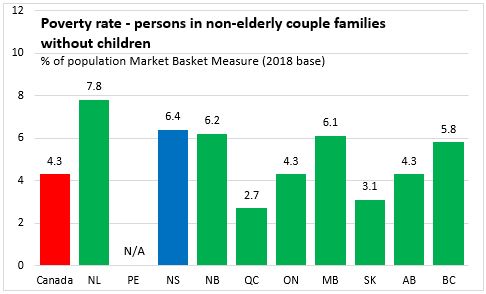
Nova Scotia's poverty rate among couples without children was rising from 2017 to 2019, but fell in 2020. The poverty rate for couples without children fell for every province in 2020 except Newfoundland and Labrador, where it rose.
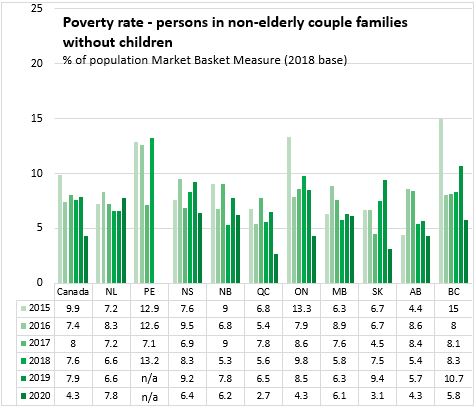
Poverty among couple families with children has been more volatile, with large increases and decreases over the past 4 years. Nova Scotia's poverty rate for couples with children fell from 9.2% in 2019 to 3.2% in 2020 . The national poverty rate among couples with children was 2.9%. The highest poverty rate for couples with children was in Prince Edward Island and the lowest was in Alberta.
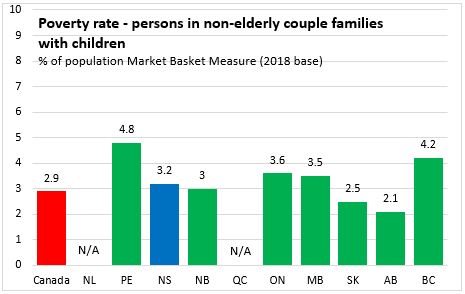
Poverty rates for couples with children have generally been declining across Canada and fell for every province in 2020 (for which data were available).
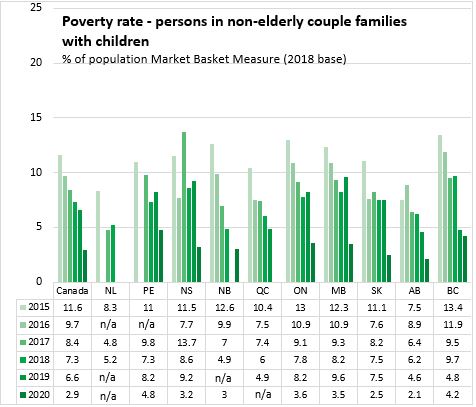
Lone parent families across the country generally report a higher poverty rate. Nova Scotia's lone parents report a poverty rate of 15.3%, which was an increase over 2019. Nationally, the poverty rate among lone parent families was 13.5%, with the highest rate in Newfoundland and Labrador.
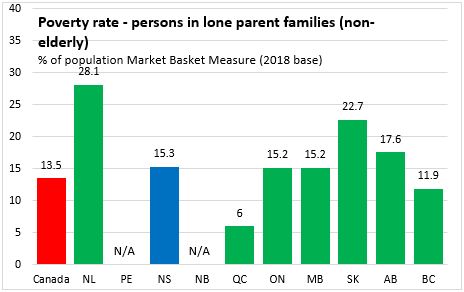
Nova Scotia's poverty rate among lone parent families have declined since 2016, with a particularly sharp drop from 2018 to 2019. Nationally, lone parent poverty rates have also been coming down since 2016.
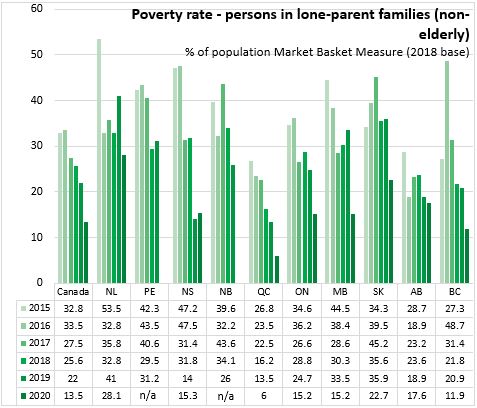
Among non-elderly persons living outside of economic families, the poverty rate remains much higher than average. Nova Scotia's poverty rate among those not in an economic family was 28.2%. Across Canada, the poverty rate among persons not in an economic family was 27.3%, with the highest rate in Ontario and the lowest in Alberta.
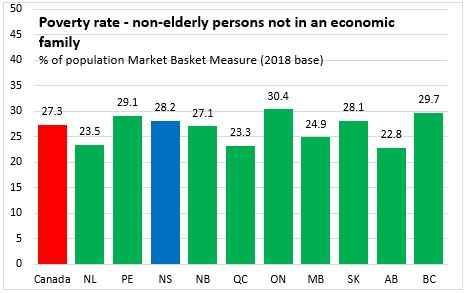
Poverty rates for non-elderly persons not in an economic family have been declining in Nova Scotia since 2015. It declined in every province in 2020. Across Canada, this poverty rate has generally been declining, with the exception of Saskatchewan.
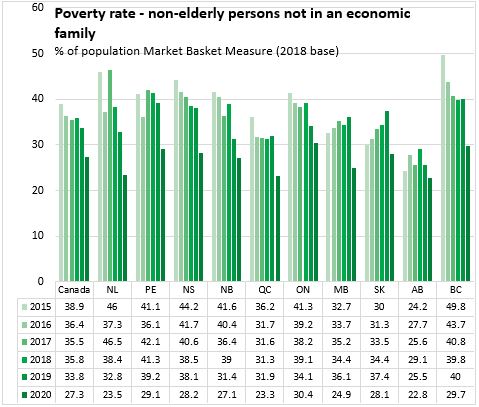
The composition of poverty by age cohort shows that the population aged 18-64 accounts for the largest portion of poverty (it is also the largest age cohort).
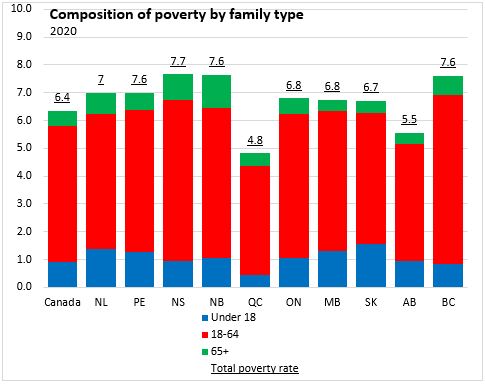
The poverty rate among children aged 17 and under was 5.5% in Nova Scotia in 2020. This was above the national average of 4.7%, but below 6 other provinces (led by Newfoundland and Labrador and Prince Edward Island). The lowest rate of child poverty in 2020 was reported in Quebec.
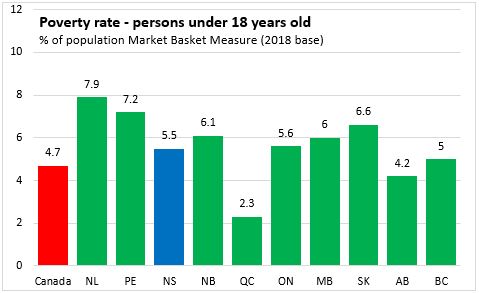
The poverty rate for children in Nova Scotia has declined considerably since 2017. National child poverty rates have been falling for several years as well.

In Nova Scotia, 9.5% of the population aged 18-64 lived with income below the poverty line in 2020. This was tied with British Columbia for the highest portion in the country. Across Canada, the poverty rate for those aged 18-64 was 7.8% with a low of 6.4% in Quebec.
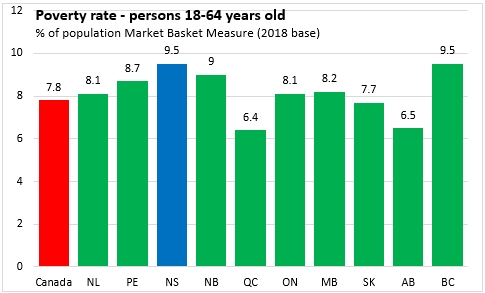
Poverty rates among those aged 18-64 have been trending down in Nova Scotia and across much of the country. In Saskatchewan, poverty rates among those aged 18-64 had been rising, but all provinces saw declines in 2020 over 2019.
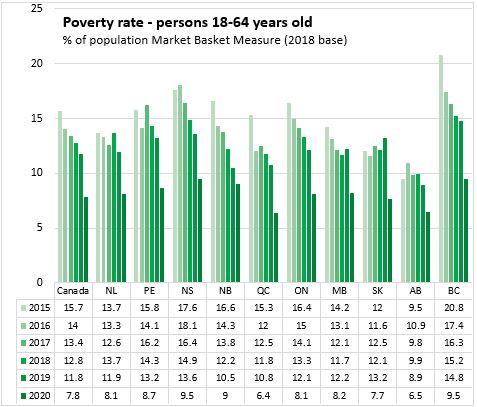
Although poverty rates for those aged 65 and older are generally lower, Nova Scotia reports the second highest poverty rate in the country for this age cohort at 4.5% (tied with Prince Edward Island). National poverty among older Canadians was 3.1% with a high of 5.1% in New Brunswick and a low of 2.3% in Quebec and Manitoba.
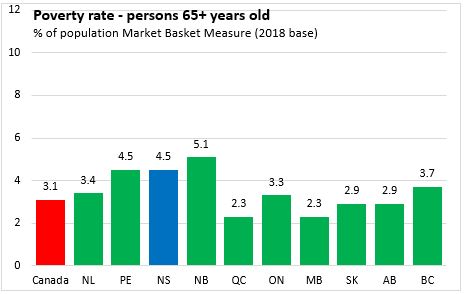
Poverty rates among older Canadians have been trending down, and every province saw a decline in 2020 over 2019.
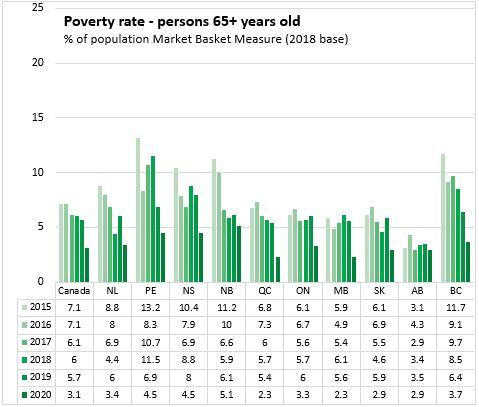
Threshold
The threshold for the poverty rate varies by province and community size. In Nova Scotia, the income required for a reference family (2 adults, 2 children) to afford a basic standard of living ranged from $42,754 in Cape Breton RM to $46,527 in Halifax. The highest thresholds were reported in larger cities across Ontario, Alberta and British Columbia. The lowest thresholds were in smaller communities of Quebec.
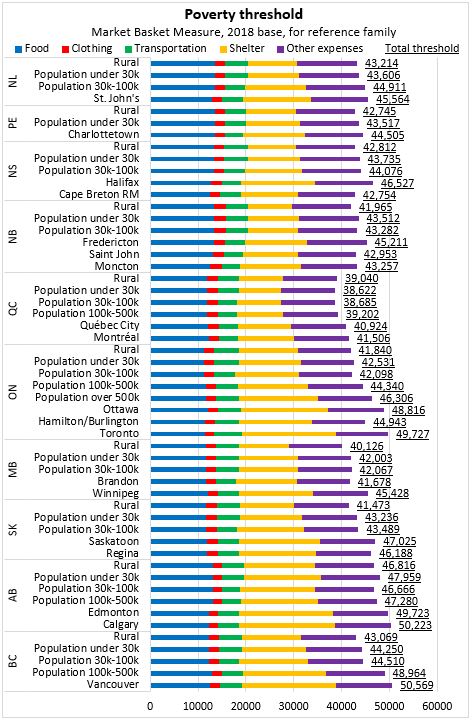
Median Incomes
Median incomes are the level of income at which half the population had higher income and half had lower income. Median incomes are frequently used in making income comparisons because, unlike averages, they are not influenced by outliers with very high values.
Median income for non-elderly couples without children in Nova Scotia was $93,700 in 2020. National median income was $101,400 with higher incomes in Alberta, Ontario and Saskatchewan and lower incomes in New Brunswick and Newfoundland and Labrador.
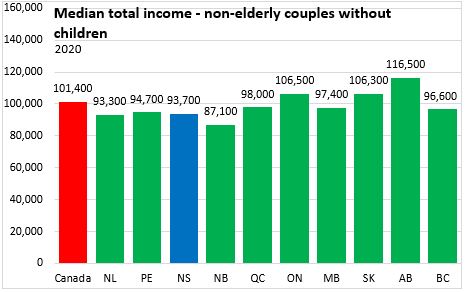
Median incomes for couples with children were higher than for couples without children. The median income of couples with children in Nova Scotia was $116,400 in 2020 (second lowest after Prince Edward Island). National median income for couple families with children was $129,300 with the highest median income in Alberta.
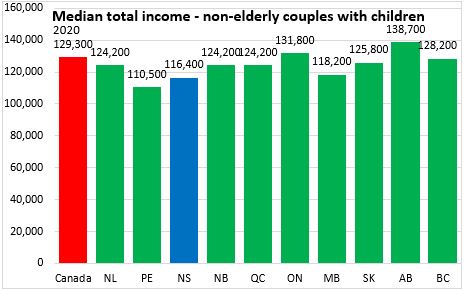
The median incomes of lone parent families and persons not in a census family are typically lower, as couples have more potential earners.
The median income of lone parent families in Nova Scotia was $57,200, lower than the national average of $64,600. Lone parent families in Newfoundland and Labrador had the lowest median incomes in 2020 while those in Alberta had the highest.
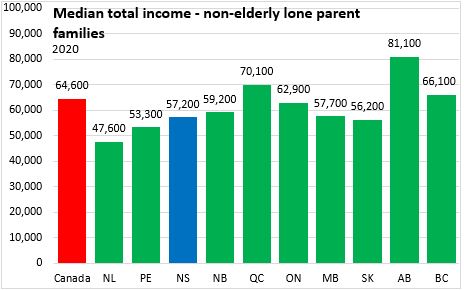
Among non-elderly persons not in an economic family, the Nova Scotia median income was $35,000 in 2020, the lowest among the provinces. National median income for non-elderly persons not in an economic family was $42,200 with a high of $45,200 in Alberta.
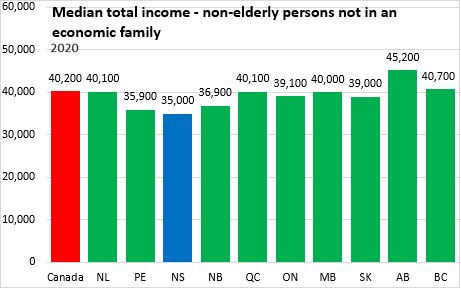
The median income of elderly families was $69,700 in Nova Scotia, which was below the national average of $75,000. Elderly couples in Alberta had the highest median incomes in 2020 while those in Newfoundland and Labrador had substantially lower median incomes.
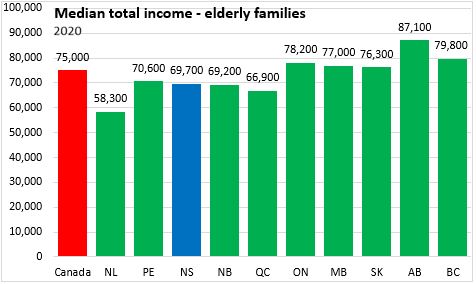
The median income among elderly persons not in an economic family was $32,800 across Canada in 2020. Elderly persons not in an economic family in Nova Scotia had a median income of $30,400. The lowest median income for non-elderly persons not in an economic family was reported in New Brunswick and the highest in British Columbia.

Income distribution
Among economic families, 44.7% of Nova Scotian families had income above $100,000 in 2020 (53.8% nationally). A further 33.1% reported incomes between $60,000 and $100,000 (28.2% nationally) while 13.5% reported incomes between $40,000 and $60,000 (12.0% nationally). A total of 8.7% of Nova Scotia economic families reported income under $40,000 (6.0% nationally).
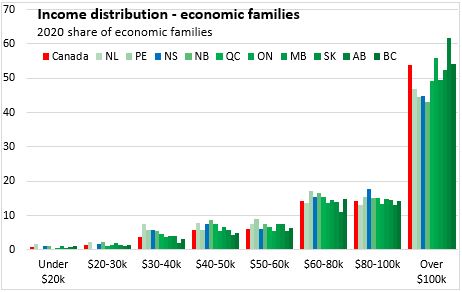
The distribution of income is notably different among persons not in an economic family. Just 3.4% of Nova Scotians not in an economic family reported income over $100,000 (6.8% nationally). Another 15.6% reported income between $60,000 and $100,000 (18.6% nationally) along with 21.6% that reported income between $40,000 and $60,000 (21.4% nationally). Among Nova Scotians not in an economic family, 43.5% reported incomes between $20,000 and $40,000 (37.3% nationally) while 15.9% (also 15.9% nationally) reported income under $20,000 in 2020.
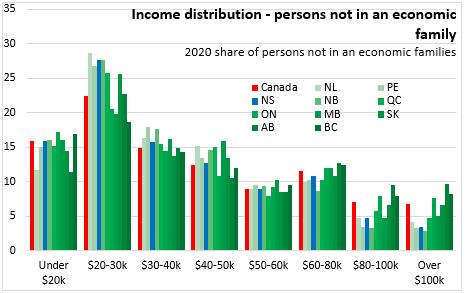
Gini coefficient of income distribution
The Canadian Income Survey also reports the Gini coefficient measure of income distribution. Gini coefficients range between zero (representing perfect equality in which all individuals have the same income) and one (representing perfect inequality in which only one person has all the income while others have none). A higher Gini coefficient means greater income inequality.
Gini coefficients can be measured for market income, total income (market income plus transfers) and after tax income (total income less taxes).
Measured by market income, Nova Scotia has a similar income distribution as the national average. However, after factoring government transfers (which are concentrated among those with less income), Nova Scotia's total income Gini coefficient is less than the national average. Likewise, Nova Scotia's after tax Gini coefficient is lower than the national average.
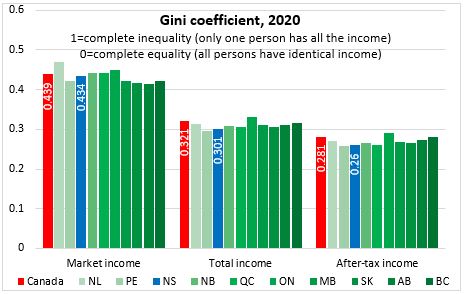
Income inequality has been decreasing since 2017 at both the national and Nova Scotia levels. This has been mainly caused by greater income equality in market sources. However, in 2020, Gini coefficients increased for market income (both provincially and at the national level) while total and after-tax inequality measures declined. This is due to the role of government transfers during the pandemic in 2020.
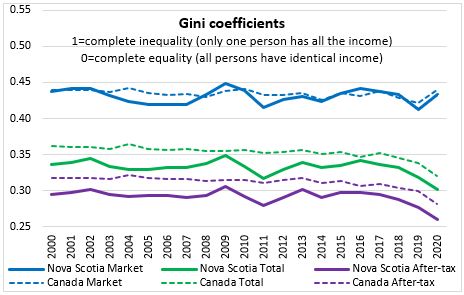
Notes and definitions
The Canadian Income Survey estimates are based on probability samples and are therefore subject to sampling variability. As a result, estimates will show more variability than trends observed over longer time periods.
The market basket measure (MBM) of poverty is based on the cost of a specific basket of goods and services representing a modest, basic standard of living. It includes the costs of food, clothing, footwear, transportation, shelter and other expenses for a reference family. These costs are compared with the disposable income of families to determine whether or not they fall below the poverty line.
An economic family refers to a group of two or more persons who live in the same dwelling and are related to each other by blood, marriage, common-law union, adoption or a foster relationship. This concept differs from the census family concept used for subprovincial data in the Annual Income Estimates for Census Families and Individuals.
The median is the level of income at which half the population had higher income and half had lower. Income estimates are expressed in 2018 constant dollars to factor in inflation and enable comparisons across time in real terms.
After-tax income is the total of market income and government transfers, less income tax.
Market income consists of employment income and private pensions, as well as income from investments and other market sources.
Government transfers include benefits such as Old Age Security, the Guaranteed Income Supplement, the Canada Pension Plan and the Quebec Pension Plan, Employment Insurance, social assistance, the goods and services tax credit, provincial tax credits, and various types of child benefits.
Sources: Statistics Canada, Canadian Income Survey:
Table 11-10-0134-01 Gini coefficients of adjusted market, total and after-tax income
Table 11-10-0135-01 Low income statistics by age, sex and economic family type
Table 11-10-0136-01 Low income statistics by economic family type
Table 11-10-0190-01 Market income, government transfers, total income, income tax and after-tax income by economic family type
<--- Return to Archive